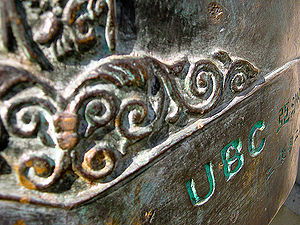Copyright:Legacy/Copyright Resources/Image Sources
Image Sources Main Page

Want to use some images in your presentation, online learning modules, or teaching and training materials? This image sources directory has been created to help UBC faculty, staff, and students find and use images in their courses while complying with Canadian copyright law. Included in this page is general information regarding the use of images for educational purposes, guidance on how to attribute images, and a directory of image sources good for instructional use.
To get started click on one of the tabs to the left.
Image Use: General
| This page will soon be updated to reflect the recent Supreme Court of Canada (SCC) copyright decisions and provisions of Bill C-11, the Copyright Modernization Act that were brought into force in November 2012. Please email any questions to: ubc-copyright@interchange.ubc.ca.) |
Using images in your work as an instructor or student differs from using textual resources. Very rarely do you want to use a portion of the image, like you do when using quotations from text. Most of the time you want to use the whole image, which is considered copying the whole work. This requires permission from the copyright holder; however, there are a few exceptions in the Canadian Copyright Act which allow the use of materials without first obtaining permission.
Fair Dealing
The Fair Dealing exception in the Copyright Act allows copying for the purposes of research, private study, criticism, review, or news reporting. For criticsm, review, or news reporting, the user must give the source of the work and, if mentioned in the source, the author/performer/maker/broadcaster. Copies made under Fair Dealing cannot be transmitted or distributed to another person, unless it is again for criticism or review. Fair Dealing applies only to personal or individual use of the copied material.
Educational Uses
The Educational Exceptions in the Copyright Act allow for:
- Temporary display of copyrighted images in the classroom for instructional purposes as long as the source and creator (or copyright holder) is credited and such temporary display is by way of :
- manual reproduction of the image by hand onto a surface intended to display handwritten material (e.g. blackboard or flip chart); or
- projection of the image using an overhead projector or similar device, provided the work is used for the purpose of education and training and is not already available in a commercial format.”
- Use of images for assessment purposes, such as an assignment, test, or exam, as long as there isn't an acceptable commercial alternative in an appropriate format for testing.
Websites, learning management systems (LMS) such as Vista, Blackboard, or MEDICOL, handouts, or printouts of a classroom slide presentations are not covered under the educational or fair dealing exceptions. Permission is required for images used in these contexts. Permissions can take the form of individual requests for permission, Creative Commons licensing, or one of the licensing agreements negotiated by the UBC Library.
When using images, it is always good practice to cite the image owner/creator and the image source both for copyright and academic integrity reasons. When looking for images online, always assume images are copyrighted unless there is evidence to the contrary.
Image Use: Attribution and Citation
The Copyright Act does not specify any citation requirements beyond the source of the material used and, if available, the name of the creator. Generally, image citations should meet the same requirements as a text citation; that is, a reader should be able to find the source of the image, and the image itself, based on the information in the citation.
For specific citation examples please see our Image Citation Guide, or jump to one of the following sections:
- Creative Commons Images
- Online Image Databases
- Websites
- Print and Electronic Publications (Journals/ Magazines/ Books)
- Library Licensed Image Databases
Many image sources, such as websites, creative commons databases, and licensed resources have specific citation requirements for use of their materials. It is always important to check the terms of use of the site or source.
Image Use FAQ
***Coming soon***
- Images from Websites
- Images from Textbooks
- Images from Journal Articles
- Citing Images in Presentation Slides
- Distributing Presentations Online
- Video Recordings of Presentations
- Creative Commons and the Public Domain